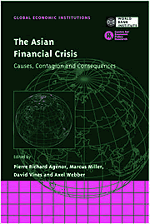Book contents
- Frontmatter
- Contents
- List of figures
- List of tables
- Preface
- List of conference participants
- Acknowledgements
- List of abbreviations and acronyms
- Introduction
- Part One General Accounts
- 1 The role of macroeconomic and financial sector linkages in East Asia's financial crisis
- Discussion
- 2 The Asian crisis: lessons from the collapse of financial systems, exchange rates and macroeconomic policy
- Discussion
- 3 Are capital inflows to developing countries a vote for or against economic policy reforms?
- Discussion
- 4 The Asian crisis: an overview of the empirical evidence and policy debate
- Discussion
- Part Two Theoretical Contributions
- Part Three Contagion
- Part Four Policy Responses
- Index
Discussion
from Part One - General Accounts
Published online by Cambridge University Press: 26 February 2010
- Frontmatter
- Contents
- List of figures
- List of tables
- Preface
- List of conference participants
- Acknowledgements
- List of abbreviations and acronyms
- Introduction
- Part One General Accounts
- 1 The role of macroeconomic and financial sector linkages in East Asia's financial crisis
- Discussion
- 2 The Asian crisis: lessons from the collapse of financial systems, exchange rates and macroeconomic policy
- Discussion
- 3 Are capital inflows to developing countries a vote for or against economic policy reforms?
- Discussion
- 4 The Asian crisis: an overview of the empirical evidence and policy debate
- Discussion
- Part Two Theoretical Contributions
- Part Three Contagion
- Part Four Policy Responses
- Index
Summary
A financial crisis is a disturbance to financial markets that disrupts the market's capacity to allocate capital – financial intermediation and hence investment come to a halt. The term ‘financial crisis’ is used too loosely, often to denote either a banking crisis, or a debt crisis, or a foreign exchange market crisis. It is perhaps preferable to invoke it only for the ‘big one’: a generalised, international financial crisis. This is a nexus of foreign exchange market disturbances, debt defaults (sovereign or private) and banking system failures: a triple crisis, in which the interactions are the key to causality, depth and persistence (Eichengreen and Portes, 1987).
The widespread securitisation of debt in recent years has not changed the picture – after all, one of the major historical examples is the 1930s crisis of defaults on sovereign bonds. Nor has it diminished the importance of banking sector fragility in provoking and exacerbating financial crises.
In chapter 4, a financial crisis is interpreted as a financial sector crisis. The stress is on banks and non-performing loans and the ultimate need for government bail-outs. This drives the story – and it provokes the exchange rate and debt crises. The framework includes explicit discussion of the impact of bail-outs on income distribution and the fiscal position. This is new and important. But my brief comments focus on the limitations of the analysis.
- Type
- Chapter
- Information
- The Asian Financial CrisisCauses, Contagion and Consequences, pp. 163 - 164Publisher: Cambridge University PressPrint publication year: 1999



